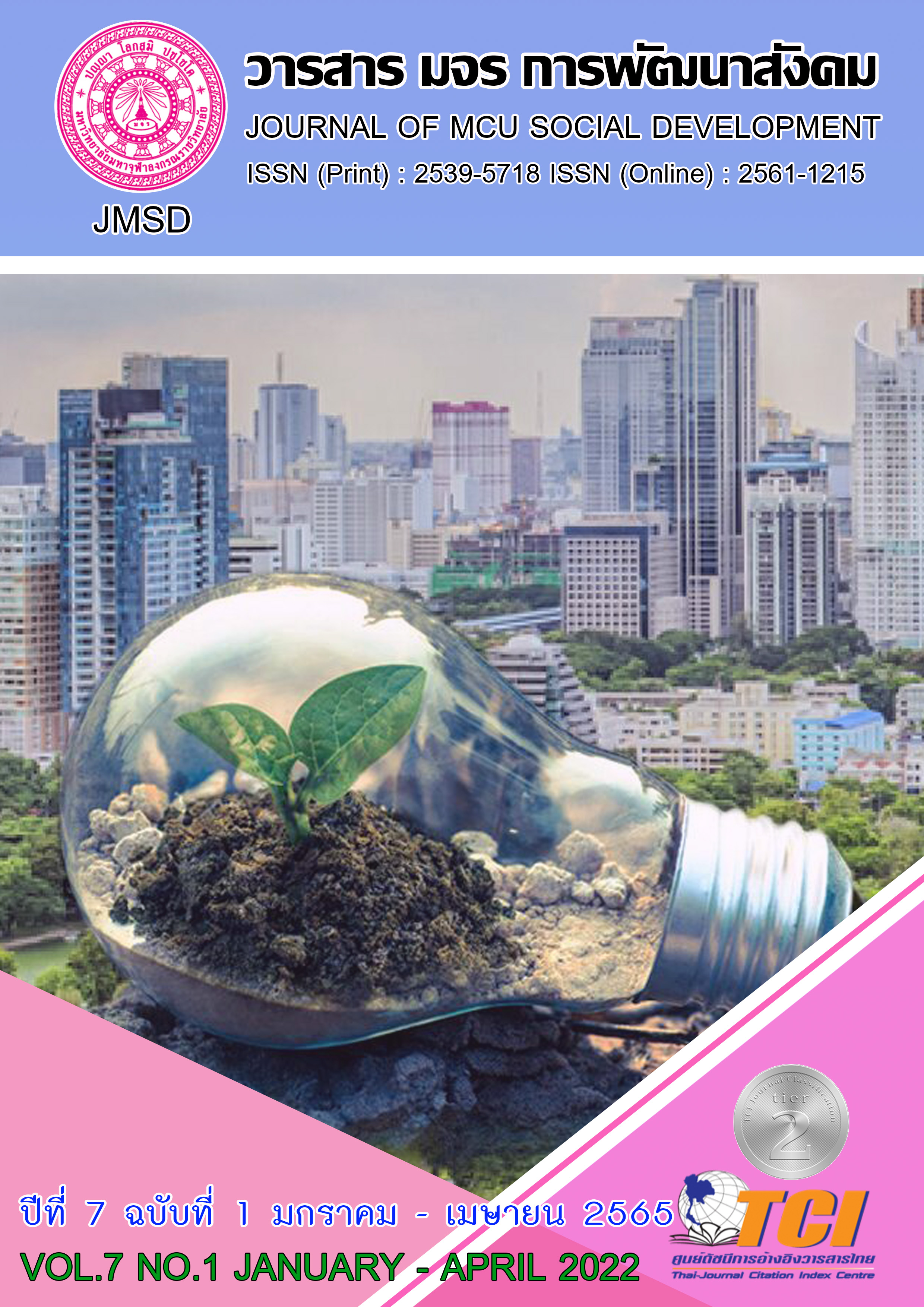Influence of causal factors on career success performance from tourism industry: study in Chonburi Province
Keywords:
sustainable development, career strategy, organizational successAbstract
This research aims to study on the influences of causal factors towards a career success performance from tourism industry in Chonburi Province. Upon analysis, the study has shown that the career strategy is the main driving factor influencing over an overall success in careers. While an employee attachment to the organization, occupational capacity, and demographic characteristics of employees are the next three influencers respectively. However, upon an overall consideration, all latent variables could describe the variation in career success of employees at a better manner.
Nonetheless, the study has also shown that the career strategy is very crucial to retrieve a success in careers. Therefore, in order to optimize the management in the organization, it is necessary to create such factors for the organization to keep developing at a sustainability. In addition, all other variables have contributed to the success in services of the tourism industry. This reflects the fact that such factors are the driving forces incorporating with career strategy to boost in the organizational development.
References
การท่องเที่ยวแห่งประเทศไทย. (2564). ข้อมูลจังหวัด/จังหวัดชลบุรี. สืบค้นเมื่อ วันที่ 5 มกราคม 2564.
จาก http://thai.tourismthailand.org/ข้อมูลจังหวัด/จังหวัดชลบุรี
จิรประภา อัครบวร. (2549). การพัฒนาทรัพยากรมนุษย์เพื่อการสร้างความผูกพันในองค์การ. วารสารข้าราชการ. 51 (พฤษภาคม - มิถุนายน): 6-7.
สุขุมพันธุ์ บริพัตร. (2554). แผนพัฒนาการท่องเที่ยวจังหวัดชลบุรี พ.ศ.2554-2558. สืบค้นเมื่อวันที่ 1 ธันวาคม 2560. จาก http://www.bangkoktourist.com/upload/document/masterplan.pdf
Robert E. Hoyt,and Andre P. Liebenberg,(2011). "The value of enterprise risk management." Journal of risk and insurance 78.4 (2011): 795-822.
Rolland Y., Czerwinski S., Abelland van kan G., Morley J.E., Cesari M., Onder G., Woo J.,Baumgartner R., Pillard F., Boirie Y., Chumlea W.M.C , and Vellas B. (2008). "Sarcopenia: ITS Assessment, Etiology, Pathogenesis, Consequences and Future Perspectives". J Nutr Health Aging. 2008 Aug-Sep; Vol 12 Issue7. pp.433–450.
Sutthichaimethee, P., (2016). Modeling Environmental Impact of Machinery Sectors to Promote Sustainable Development of Thailand., Journal of Ecological Engineering, 17 (1) : 18-25.
Sutthichaimethee, P., (2017). VARIMAX Model to Forecast the emission of Carbon Dioxide from Energy Consumption in Rubber and Petroleum industries sectors in Thailand. Journal of Ecological Engineering, 18 (3) : 112-117.
Sutthichaimethee, P., &Ariyasajjakorn, D., (2017 a). The Revised Input-Output Table to Determine Total Energy Content and Total Greenhouse Gas Emission Factors in Thailand. , Journal of Ecological Engineering, 18 (6) : 12-19.
Tho D. Nguyen, Nigel J. Barrett, Kenneth E. Miller, (2011). "Brand loyalty in emerging markets", Marketing Intelligence & Planning, Vol. 29 Issue: 3, pp.222-232.
Tsai, Y.-H. (2005). Quantifying Urban Form: Compactness versus 'Sprawl'. Sage Journal. Volume: 42 issue: 1, page (s) : 141-161.
Wu, D. D., Chen, S. H., & Olson, D. L. (2014). Business intelligence in risk management: Some recent progresses. Information Sciences, 256, 1-7.
Wu, S.C., Cao, Z.H., Li, Z.G., Cheung, K.C. and Wong, M.H. (2005). Effects of Biofertilizer Containing N-fixer, P and K Solubilizers and AM Fungi on Maize Growth: a Greenhouse Trial. Geoderma, 125:155–166.
Grace, J. B. (2008). Structural equation modeling for observational studies. Journal of Wildlife Management, 72(1), 14-22.
Lindeman, R. H., M erenda, P. F., & Gold, R. Z. (1980). Introduction to bivariate and multivariate analysis. Glenview, IL: Scott, Foresman and company
Zhu, B., Walter, S., Rosenbaum, P., Russell, D., & Raina, P. (2006). Structural equation and log-linear modeling: A comparison of methods in the analysis of a study on caregivers’ health. BMC Medical Research Methodology, 6 (1) ,49.
Akrivos, C., Ladkin, A., & Reklitis, P. (2007). Hotel managers' career strategies for success. International Journal of Contemporary Hospitality Management, 19(2), 107-119.
Eddleston, K. A., Baldridge, D. C., and Veiga, J. F. (2004). Toward modeling the predictors of managerial career success: Does gender matter?, Journal of Managerial Psychology,19(4), 360-385.
Eddleston, K. A., Baldridge, D. C., and Veiga, J. F. (2004). Toward modeling the predictors of managerial career success: Does gender matter?, Journal of Managerial Psychology,19(4), 360-385.
Vanderheijden, B. I. J. M., Delange, A. H., Demerouti, E., & Vander Heijde, C. M. (2009). Age effects on the employability’s career success relationship. Journal of Vocational Behavior, 74(2), 156-164.
Lertwannawit, A., Serirat, S., & Pholpantin, S. (2009). Career Competencies And Career Success Of Thai Employees In Tourism And Hospitality Sector. The International Business & Economics Research Journal, 8(11), 65-72.
Ashby, J. S., & Schoon, I. (2010). Career success: The role of teenage career aspirations, ambition value and gender in predicting adult social status and earnings. Journal of Vocational Behavior, 77(3), 350-360.
Blickle, G., Oerder, K., &Summers, J. K. (2010). The impact of political skill on career success of employees' representatives. Journal of Vocational Behavior, 77(3), 383-390.
Akram, A. A. (2010). Modes of engagement: Migration, self-initiated expatriation, and career development. Career Development International, 15(4), 338-358.
Gruman, J. A., & Saks, A. M. (2011). Performance management and employee engagement. Human Resource Management Review, 21(2), 123-136.
Yakin, M., & Erdil, O. (2012). Relationships between self-efficacy and work engagement and the effects on job satisfaction: A survey on certified public accountants. Procedia – Social and Behavioral Sciences, 58, 370 – 378.



